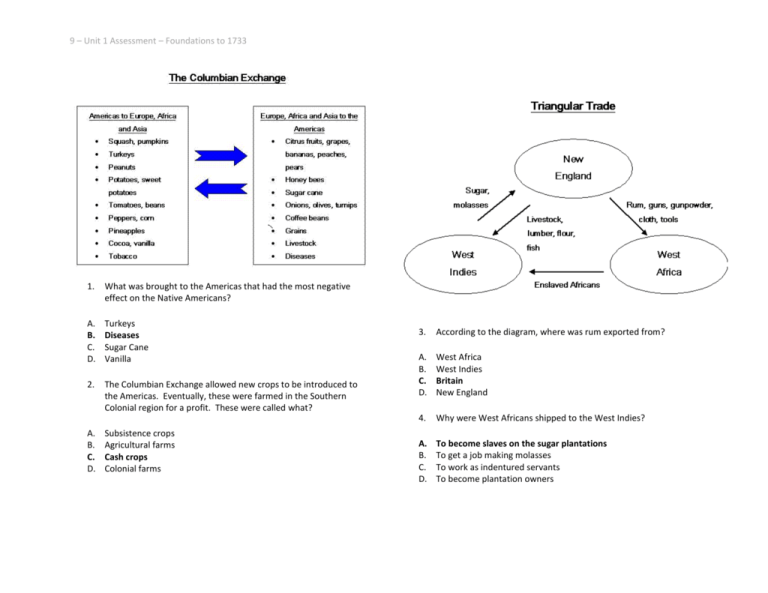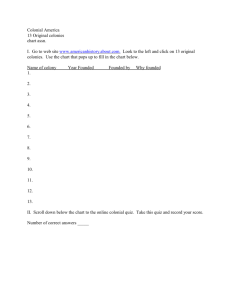Assessment - Foundations to 1733
advertisement

9 – Unit 1 Assessment – Foundations to 1733 1. What was brought to the Americas that had the most negative effect on the Native Americans? A. B. C. D. Turkeys Diseases Sugar Cane Vanilla 2. The Columbian Exchange allowed new crops to be introduced to the Americas. Eventually, these were farmed in the Southern Colonial region for a profit. These were called what? A. B. C. D. Subsistence crops Agricultural farms Cash crops Colonial farms 3. According to the diagram, where was rum exported from? A. B. C. D. West Africa West Indies Britain New England 4. Why were West Africans shipped to the West Indies? A. B. C. D. To become slaves on the sugar plantations To get a job making molasses To work as indentured servants To become plantation owners 10 – Unit 1 Assessment – Foundations to 1733 5. What is represented by Triangular Trade? A. B. C. D. neutrality interdependence imperialism alliances 6. What part of Triangular Trade transported slaves to the Americas? A. B. C. D. Columbian Exchange Atlantic Trade Route Middle Passage Slave Passage Base your answer on the map. 7. What types of goods were shipped from England to the colonies? A. slaves, gold, and pepper B. sugar and molasses C. manufactured goods D. rum and iron 8. This map deals mainly with which aspect of colonial life? A. B. C. D. political social economic religious 11 – Unit 1 Assessment – Foundations to 1733 Base your answer on the map. 9. What would be the best title for this map? A. B. C. D. British Domination of the Americas Colonial Trade Routes Spanish Colonies in the New World The United States in 1750 10. This map shows the western limit on colonial settlement that resulted from what? A. B. C. D. founding of Jamestown Proclamation of 1763 Monroe Doctrine Compromise of 1850 12 – Unit 1 Assessment – Foundations to 1733 11. Which of the following activities were permitted the American colonists by the British Acts of Navigation and Trade (the Navigation Acts)? A: They could use American-built ships to trade within the Empire. B: They could ship fish from America to southern Europe. C: They could import sugar and molasses from the British West Indies tax-free. D: They could manufacture certain products not manufactured in Great Britain. 12. Based on this map, which statement about the geography of colonial New England is most accurate? 1. 2. 3. 4. New Hampshire had the highest population density. Rivers served as natural boundaries between the colonies. The first communities developed along rivers and coastlines. The Atlantic Ocean isolated the region from the rest of the colonies. 13 – Unit 1 Assessment – Foundations to 1733 13. Which heading best completes the partial outline below? [L]ive peaceable under the civil government, . . . nor shall he or she at any time be compelled to frequent or maintain any religious worship place or ministry whatever . . . that so we may live friendly together. . . . That the Indians shall have liberty to do all things to the improvement of their ground. William Penn, 1682 15. How did William Penn’s principles regarding his “holy experiment” colony affect those who chose to settle in Pennsylvania? A. Factors in the Economic Development of Colonial New England B. Reasons for the Development of Southern Plantations C. Features Contributing to Dutch Success in Colonial New Amsterdam D. Components of the British System of Mercantilism 14. Which resources or commodities contributed most to the economic success of Jamestown colony? A. Coal B. Cotton C. Tobacco D. Naval stores A. Many citizens left the colony to find education for their children. B. The colony experienced minimal growth due to the religious intolerance of its leaders. C. American Indians and colonists often worshiped together. D. Penn′s approach made the colony diverse by attracting many types of people and religions. 16. In the Colonial Era, developments such as the New England town meetings and the establishment of the Virginia House of Burgesses represented what? A. colonial attempts to build a strong national government B. efforts by the British to strengthen their control over the colonies C. steps in the growth of representative democracy D. early social reform movements 17. The Mayflower Compact is important to the concept of a democratic society because it represents what? A. B. C. D. an effort by the colonists to use force to resist the King a clear step toward self-government an early attempt to establish universal suffrage an attempt by the colonists to establish freedom of religion 14 – Unit 1 Assessment – Foundations to 1733 18. In its economic relationship with its North American colonies, Great Britain followed the principles of 18th-century mercantilism by doing what? A. outlawing the African slave trade B. limiting the colonies’ trade with other nations C. encouraging the development of manufacturing in the colonies D. establishing laws against business monopolies 19. In which area did good harbors, abundant forests, rocky soil, and a short growing season most influence the colonial economy? A. Southern colonies B. Middle Atlantic region C. Northwest Territory D. New England colonies Constructed Response Questions: 1. Analyze the effect of colonization on the Americas and its aftermath on the relationship between natives and the British colonies. Confine your response to the period from 1607 – 1733. 2. Evaluate the impact that the Mayflower Compact had on the development of the colonial government system in the American Colonies. 3. Compare and contrast the ways that Native Americans both benefitted and suffered from the presence of early American colonists.





